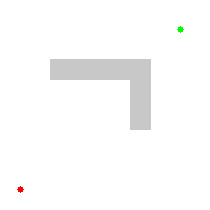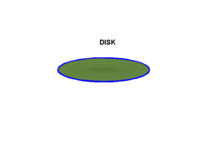User:Subh83/CommonsContrib
Animated GIFs illustrating Dijkstra's, A* and weighted A* search algorithms
[edit] |
 |
 |
The above figures illustrate a typical example from motion planning in robotics using 3 different search algorithms (all variants of A*). The graph is created by uniform square discretization of a 2-dimensional planar region, placing a node in each discretized cell, and connecting each node with its 8 neighbors using bidirectional edges. Cost of edges are same as their Euclidean lengths. The gray shape represents an obstacle. The filled circles in red & green represent expanded nodes (nodes in closed set). The color indicate the g-score (red: lower g-score, green: higher g-score). The empty nodes with blue boundary are the ones in open set. The nodes of the graph are generated on the fly, and nodes falling inside the obstacle are discarded as inaccessible. The objective is to find the least cost path (restricted to the graph) from a given start to a given goal node. A consistent heuristic in this problem is the Euclidean distance of a node to goal. That is, ha(n) = |g - n|2, where n represents the Euclidean coordinate of the node n, g is the goal node, and | . |2 is the 2-norm.
These animations were created using YGSBPL graph-search library and OpenCV.
Animated GIF illustrating simple construction of a quotient space
[edit] |
The adjacent figure illustrates construction of a simple quotient space. The boundary (in blue) of a 2-disk when identified (glued together) to a single point, gives the topological 2-sphere. In general, . More precisely, it is the adjunction space , where is a single point, and with such that .
The animation was created using MATLAB and ImageMagick. |
Functors and Category theory related Illustrations
[edit]Below are a couple of simple illustrations for the Hom functor, hoping it will help people to grasp the concept more easily, as well as help in remembering the definition of the functor.
 |
Fix . Then there are sets of morphisms , , etc. Also, for , we define a map , i.e. by (illustrated by the dashed arrow). Thus is a covariant functor. |













